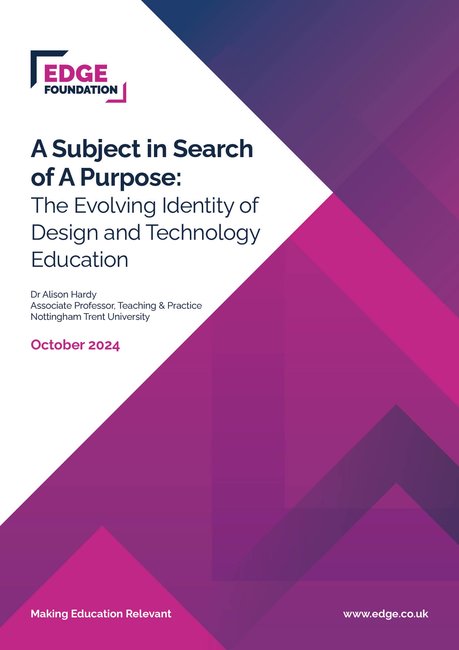Design and Technology (D&T) education has long played a role in developing individual creativity, vocational skills and contributing to a prospering society. In a new report commissioned by Edge, I explore D&T’s history from its origins over a century ago to its “official inauguration” as a subject in 1990 and beyond. Over the past hundred years, various tensions and debates have colluded – or fought – to shape the identity, purpose, and content of Design and Technology as a subject. Today, as we endeavour to educate a generation of young people facing the most uncertain of futures, I hope that exploring how the subject has evolved can teach us important lessons for the future. As a subject in its own right, “Design and Technology” did not emerge until 1990. While this may suggest a young discipline, this could hardly be further from the truth.

In reality, as far back as 1850 – long before any curriculum as we recognise it today – there was a funding requirement to teach needlework to girls and later in 1888 a push to promote training in woodwork, ironwork, and other subjects that would help boys acquire a trade. The aim back then was to give children skills for life, employment and to revitalise England’s ailing status as an industrial power. Later, subjects like manual work, housewifery, drawing and practical work were formalised into a broad curriculum in 1904’s Regulations for Secondary Schools. In turn, this laid the foundations for the 1944 Education Act, which created England's tripartite education system.
The tripartite system introduced grammar schools, modern schools, and finally, technical schools, which taught the scientific and technical subjects that would later become associated with D&T. Nevertheless, technical schools represented a small percentage of learner pathways in a system dominated by academia or low-skilled work. By the 1960s, the continuing growth of technology and manufacturing led to calls for a curriculum that reflected these changes. The Ministry of Education’s 1962 Crowther Report proved highly influential for practical and technical education. It was perhaps the first report to explicitly assert that the academic road was not “the only road by which good minds can travel”, the alternative being non-academic and practical.

While it did not provide clear definitions, it marked the first major argument in decades of debate, discussion and disagreement about the subject that would eventually become Design & Technology. From the 1960s to the 1990s, further socioeconomic shifts, the growth of complex industries and associated change in political winds created a new demand for design and technological education. The tripartite system was eventually scrapped in 1976, but design and technology education was by now a charged political topic.
Needless to say, the full report details how D&T emerged from a complex interplay of different disciplines and policy shifts. The subject’s history – although certainly colourful – is peppered with consistent themes, particularly around the tension between vocational and general education, challenges in defining what “technology” means, and the subject’s struggle to find status within a largely academic curriculum. Despite facing challenges, D&T’s survival through six versions of the National Curriculum demonstrates its essential role in fostering creativity, technological awareness, and problem-solving. Over the past century, D&T subjects have addressed social and individual needs, responded to technological advancements and catered to a diversity of learners. They’ve also cultivated core skills and values like empathy, communication and moral development – attributes that remain highly valued by employers today. While not unique to D&T, these interdisciplinary skills find their most effective expression within this unique subject.

So what is the report’s ultimate aim? With the new government’s Curriculum and Assessment Review, we face a once-in-a-generation opportunity to reaffirm D&T’s role. In general, I hope that by compiling a history, policymakers can learn from past mistakes and successes. In particular, I have identified six initial lessons to get things started:
- Clarity of purpose: D&T has long struggled to define its core purpose. Future curriculum development must clearly articulate D&T's unique contribution to students' education: developing their ability to critically engage with the made world, design innovative solutions, and become active, informed citizens in a technological society.
- Responsiveness to societal changes: D&T has consistently responded to technological advancements and changing economic needs. Future curricula should balance this adaptability with an enduring foundation of principles and skills.
- Inclusivity: The subject’s history reflects a journey from gendered curricula to a more inclusive approach. We must continue ensuring that D&T is accessible and relevant to all students, regardless of gender, background, or aspirations.
- Tradition and innovation: While embracing new technologies and practices, we should not discard established skills and knowledge. D&T’s history shows the importance of evolution rather than revolution in curriculum development.
- Stakeholder engagement: The most successful curriculum changes involve input from stakeholders including teachers, industry professionals, higher education, and subject associations. We should continue this collaborative approach.
- Status within the curriculum: D&T’s position has fluctuated from core subject to “entitlement”. Now is the time to make a strong case for D&T’s value in a broad and balanced curriculum, drawing on its unique ability to integrate multidisciplinary knowledge and skills.
Design and Technology has not always faced an easy ride. However, its resilience and adaptability demonstrate its importance for equipping learners with the skills and knowledge to adapt and thrive in a complex, technological world. Whatever happens, I am certain that this will remain the case and I strongly believe that this report can help smooth the onward journey.
By Dr Alison Hardy
Dr Alison Hardy is an Associate Professor at Nottingham Institute of Education and host of the Talking D&T podcast.

